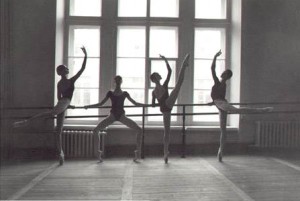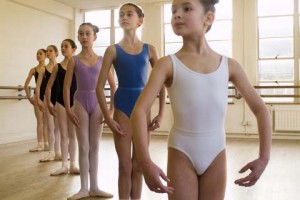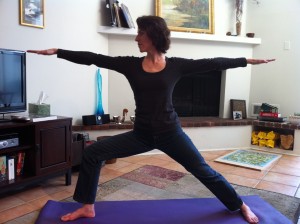 Last week I played with the ballet. For those who know me, it is no secret that I love dance. I even took some beginner ballet classes last year so that I could experience it first-hand. I had a wonderful teacher here in Philadelphia who somehow managed to weave dance history, theory and philosophy in with the physical movements that he taught us, and it was enlightening!
Last week I played with the ballet. For those who know me, it is no secret that I love dance. I even took some beginner ballet classes last year so that I could experience it first-hand. I had a wonderful teacher here in Philadelphia who somehow managed to weave dance history, theory and philosophy in with the physical movements that he taught us, and it was enlightening!
 The very first thing that I learned in ballet class was correct stance – the neutral posture from which your body moves and where your body returns. Everything is specified – down to the arrangement of the fingers, the expression on the face, and even the direction of the gaze of the eyes. When these details have been tended to, what you get is the embodiment of poise.
The very first thing that I learned in ballet class was correct stance – the neutral posture from which your body moves and where your body returns. Everything is specified – down to the arrangement of the fingers, the expression on the face, and even the direction of the gaze of the eyes. When these details have been tended to, what you get is the embodiment of poise.
One of the things I find most impressive about great ballet dancers is that, no matter what they are feeling – and they can feel a lot of very unpleasant things – they always exude a sense of balance, grace and ease. It takes a lot of discipline to put that face on when you’re not particularly feeling like dancing, or if your energy is sapped, or if you are even in pain.
I often approach horn playing and any of life’s endeavors from the inside-out, and this is generally a good thing, I think. As the fox in The Little Prince says, “What is essential is invisible to the eye.” So the inside is always the most important in my view. However, what I’ve found is that it can be extremely helpful to approach whatever endeavor is at hand (for our purposes at the moment – horn playing) from both directions – the outside-in as well as the inside-out.
For example, there are times when the practice room or the stage is the last place you want to be. This is just life. Things can get us physically and/or emotionally and it’s hard to get out the horn and gear up to get some work done. This is when an outside-in approach and poise comes in very handy. You pull your shoulders back, un-wrinkle your forehead, take a deep breath, and “just do it.” And sometimes it can happen that your inner thoughts and emotions react to the expression you have put on your face, how you sit, and how your eyes are focused. They can “perk up” or “calm down” – or whatever is needed at the moment.
 The idea that what happens in the body has an effect on the emotions and mental state is an integral part of certain approaches to yoga and one of the things I love most about it. For example, what happens when you place yourself in a particular yoga pose is that you are “putting on” outwardly the qualities that can stand to be exercised and warmed-up on the inside. So for instance, when I am in warrior pose, legs strong and rooted, chest open, radiating out from my center through my arms and legs, soft but focused gaze – these physical actions can nudge my mind and emotions towards the corresponding inner qualities. In the case of warrior pose, these might be grounded-ness, an open heart, energy, and strong intention.
The idea that what happens in the body has an effect on the emotions and mental state is an integral part of certain approaches to yoga and one of the things I love most about it. For example, what happens when you place yourself in a particular yoga pose is that you are “putting on” outwardly the qualities that can stand to be exercised and warmed-up on the inside. So for instance, when I am in warrior pose, legs strong and rooted, chest open, radiating out from my center through my arms and legs, soft but focused gaze – these physical actions can nudge my mind and emotions towards the corresponding inner qualities. In the case of warrior pose, these might be grounded-ness, an open heart, energy, and strong intention.
Though yoga can provide an opportunity to physically practice qualities that are desired on the inside, you don’t have to be a yogi, or even remotely interested in yoga, to experience the benefits of this outside-in way of thinking. You can experiment with this right away by simply sitting up straight, or smiling, or pulling your shoulders back, or relaxing the focus of your eyes so that you are aware of the entire room in your periphery. Can you feel how the rest of your body and your inner state can respond to these little changes?
These are great skills to have in your bag of tricks when you don’t feel spectacular, but need to get some work done anyway.
Outside-in can also be really helpful in learning a new skill, as long as it’s balanced by inside-out. It is similar to acting, or taking a “fake-it-till-you-make-it” approach. It’s very interesting to test limits by “trying something on” for a while even if it feels foreign. For instance, let’s say you’ve done the technical work necessary on a certain passage, but still haven’t developed confidence in it. One way to approach this would be to contemplate what it might look and feel like to be confident about it. Imagine it, put it on, and give it a whirl. You might surprise yourself. From there, you work on incorporating that attitude into your playing every time you approach that passage so that the new skill of confidence works its way into you and becomes something you can count on.
I don’t mean to advocate being disingenuous – I believe it is totally fine to feel how you feel and to be genuine about it. There are times, however, when, in order to get out of a rut or to get to the next level, or to just plain get through a performance, it is helpful to contemplate something outside ourselves in order to free ourselves up. It is all too easy to get caught up in inner dramas. This is a way to “just do it!”
Even more important than poise is what poise develops into over a longer period of time and with larger obstacles – resilience! Resilience also includes the ability to improvise, to think calmly when all around you seems to be crumbling, and to generally ride the waves of life and not get pulled under.
My husband and I were talking recently about our fast-moving, fast-changing world. One thing he says is that success in our quickly-changing world is going to be determined by how calmly and clearly one can think under stress and upheaval.
When things change, stress naturally follows because we human beings do NOT like it. We prefer stability and certainty – and why not!? This is when we feel most at ease and comfortable – this is when we feel we can enjoy life. But if we can get in the habit of thinking clearly and staying poised when bobbles big and small are going on around us, we have a chance. This ability to not allow ourselves to get caught in downward-spirals (from within or without!) or to whipped into a frenzy about things gives us a chance to breathe, see alternatives, and think in a different way.
I must add that I don’t think it is easy to do this alone. It is always helpful to have others around us who aid in resisting the pull of the downward spirals. Good friends, family and community are so important. This is where we find support, get ideas, bounce new ways of thinking off of each other, and find ways to help each other through hard times.
So, can I say it? Give poise a chance!
Resources:
Antoine de Saint-Exupéry, The Little Prince
Donna Farhi, Yoga Mind, Body, and Spirit

One Response to The Potential of Poise, from the Outside-In